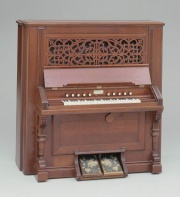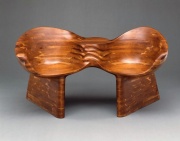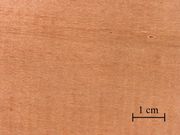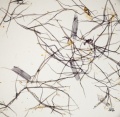Difference between revisions of "Cherry wood"
| (One intermediate revision by the same user not shown) | |||
| Line 29: | Line 29: | ||
* Schoch, W., Heller, I., Schweingruber, F.H., Kienast, F., 2004:[http://www.woodanatomy.ch/ Wood anatomy of central European Species]: Stone Fruit: Cherry,[http://www.woodanatomy.ch/species.php?code=PNAV Prunus avium L.] | * Schoch, W., Heller, I., Schweingruber, F.H., Kienast, F., 2004:[http://www.woodanatomy.ch/ Wood anatomy of central European Species]: Stone Fruit: Cherry,[http://www.woodanatomy.ch/species.php?code=PNAV Prunus avium L.] | ||
* Alden Identification Services, Microscopic Wood Identification: [https://wood-identification.com/wood-types/ Link] | * Alden Identification Services, Microscopic Wood Identification: [https://wood-identification.com/wood-types/ Link] | ||
| − | |||
* G.S.Brady, ''Materials Handbook'', McGraw-Hill Book Co., New York, 1971 Comment: p. 184 | * G.S.Brady, ''Materials Handbook'', McGraw-Hill Book Co., New York, 1971 Comment: p. 184 | ||
| − | |||
* Ralph Mayer, ''A Dictionary of Art Terms and Techniques'', Harper and Row Publishers, New York, 1969 (also 1945 printing) | * Ralph Mayer, ''A Dictionary of Art Terms and Techniques'', Harper and Row Publishers, New York, 1969 (also 1945 printing) | ||
| − | |||
* F. H. Titmuss, ''Commercial Timbers of the World'', The Technical Press Ltd., London, 1965 Comment: 38-45 ppcf | * F. H. Titmuss, ''Commercial Timbers of the World'', The Technical Press Ltd., London, 1965 Comment: 38-45 ppcf | ||
| − | |||
* ''Dictionary of Building Preservation'', Ward Bucher, ed., John Wiley & Sons, Inc., New York City, 1996 | * ''Dictionary of Building Preservation'', Ward Bucher, ed., John Wiley & Sons, Inc., New York City, 1996 | ||
| − | |||
* ''Encyclopedia Britannica'', http://www.britannica.com Comment: "Cherry." Accessed: 18 May 2004 . | * ''Encyclopedia Britannica'', http://www.britannica.com Comment: "Cherry." Accessed: 18 May 2004 . | ||
| − | |||
* Virginia Tech Dendrology website at www.fw.vt.edu/dendro/dendrology/main.htm (Accessed Dec. 9, 2005) | * Virginia Tech Dendrology website at www.fw.vt.edu/dendro/dendrology/main.htm (Accessed Dec. 9, 2005) | ||
| − | |||
* H.L.Edlin, ''What Wood is That?'', Viking Press, New York, 1969 | * H.L.Edlin, ''What Wood is That?'', Viking Press, New York, 1969 | ||
| − | + | * Wikipedia: [https://en.wikipedia.org/wiki/Cherry Cherry] (Accessed Dec. 9, 2005 and October 2024) | |
| − | * Wikipedia: | ||
| − | |||
* ''CRC Handbook of Chemistry and Physics'', Robert Weast (ed.), CRC Press, Boca Raton, Florida, v. 61, 1980 Comment: density=43-56 ppcf (0.70-0.90 g/cm3) | * ''CRC Handbook of Chemistry and Physics'', Robert Weast (ed.), CRC Press, Boca Raton, Florida, v. 61, 1980 Comment: density=43-56 ppcf (0.70-0.90 g/cm3) | ||
| − | |||
* Walter Rantanen. "Fiber ID Course." Integrated Paper Services. June 2013. Lecture. | * Walter Rantanen. "Fiber ID Course." Integrated Paper Services. June 2013. Lecture. | ||
| − | [[Category:Materials database]] | + | [[Category:Materials database]][[Category:MWG]][[Category: Wood]] |
Latest revision as of 11:57, 3 October 2024
Description
Wood from any cherry tree, especially the wild cherry (Prunus avium) or the Black cherry (Prunus serotina). Cherry trees have a smooth reddish brown bark and white blossoms in spring. The close, even-grain wood is strong and smells like roses when freshly cut. It is brownish to light red in color but darkens on exposure. Cherry wood takes a high polish and is valued for instrument cases, furniture, veneers, cabinetry, turnery and decorative items. It was formerly used for airplane propellers. The demand for cherry wood is usually greater than the supply. Other cherry trees used for their wood include the African cherry or makore (Mimusops heckelii); Austrian cherry (Prunus mahaleb); and European cherry (Prunus cerasus).
Synonyms and Related Terms
cherrywood; mazzard (England); merisier (Fr.); cerisier (Fr.); Kirsche (Deut.); ciliegio (It.); cerezo (Esp.); sakura (Jap.); black cherry; Prunus mahaleb (Austrian cherry); Mimusops heckelii (African cherry, makore); Prunus cerasus (European cherry, sour cherry); Prunus avium (wild cherry, sweet cherry); Prunus serotina (black cherry);
Physical and Chemical Properties
Color: uniform light reddish brown that darkens with age. Rings: distinct. Pores: diffuse, fine. Gain: distinct. Rays: distinct. Hard, lightweight, pleasant smelling. Density = 38-56 ppcf. Specific gravity = 0.63
Paper fiber type: hardwood, diffuse porous. Using transmitted light microscopy, pulp is identified by vessels with irregular open spiraling. Perforations are simple. Appearance with Graff "C" stain: dark blue, but varies with bleaching. Common pulping method: kraft.
Additional Images
Resources and Citations
- Schoch, W., Heller, I., Schweingruber, F.H., Kienast, F., 2004:Wood anatomy of central European Species: Stone Fruit: Cherry,Prunus avium L.
- Alden Identification Services, Microscopic Wood Identification: Link
- G.S.Brady, Materials Handbook, McGraw-Hill Book Co., New York, 1971 Comment: p. 184
- Ralph Mayer, A Dictionary of Art Terms and Techniques, Harper and Row Publishers, New York, 1969 (also 1945 printing)
- F. H. Titmuss, Commercial Timbers of the World, The Technical Press Ltd., London, 1965 Comment: 38-45 ppcf
- Dictionary of Building Preservation, Ward Bucher, ed., John Wiley & Sons, Inc., New York City, 1996
- Encyclopedia Britannica, http://www.britannica.com Comment: "Cherry." Accessed: 18 May 2004 .
- Virginia Tech Dendrology website at www.fw.vt.edu/dendro/dendrology/main.htm (Accessed Dec. 9, 2005)
- H.L.Edlin, What Wood is That?, Viking Press, New York, 1969
- Wikipedia: Cherry (Accessed Dec. 9, 2005 and October 2024)
- CRC Handbook of Chemistry and Physics, Robert Weast (ed.), CRC Press, Boca Raton, Florida, v. 61, 1980 Comment: density=43-56 ppcf (0.70-0.90 g/cm3)
- Walter Rantanen. "Fiber ID Course." Integrated Paper Services. June 2013. Lecture.







